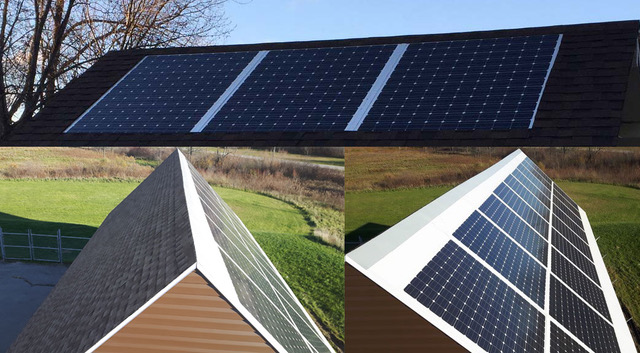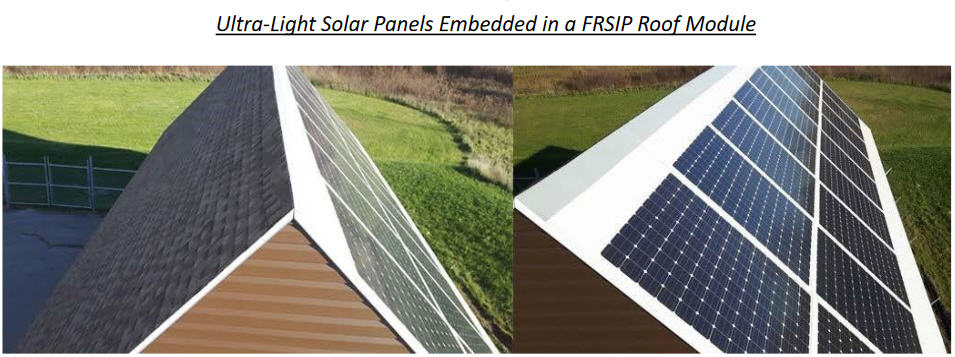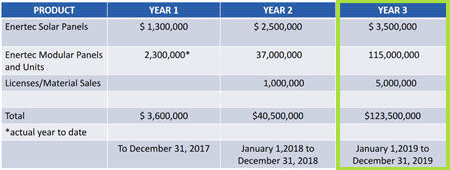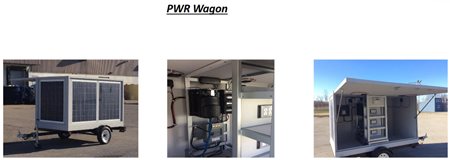EnerDynamic Hybrid Technologies Corp. epitomizes this strategy. Investors looking at this name may scratch their heads and ask, “What does this Company do?”. Well, it does a lot.
We live in a world of constant construction: residential, commercial, and industrial buildings. When structures wear out (or are damaged by hurricane, fire, flood, or other natural disasters), we build new ones.
EHT looked at this world of constant construction and decided to produce a better building material, for its ENERTEC product line.
What is this building material?
The Company calls it a FRSIP panel (Fiberglass Reinforced Fire Retardant Structural Insulated Panel). That’s a mouthful. But in a conference call with Stockhouse Editorial, CEO John Gamble dumbed-down the technology, and highlighted some of its superior qualities.
A traditional Structural Insulated Panel (SIP), consisting of a piece of foam with sheets of oriented strand board (OSB) glued on to each side, is used to erect insulated walls quickly but must have a fully framed wall to which they attach.
These SIPs function but still require expensive, slow-building techniques of framing first and are not fire rated thus mandating a further installation (and cost) of drywall to meet fire codes. Our Fire Rated Structural Insulated Panel (FRSIP) requires no framing. Fire rated proprietary fiberglass skin is fused to both sides of polystyrene foam in any seamless dimension up to 10 feet wide and 40 feet long. A wall of a house can be one solid piece with an 8’to 10’ ceiling height.
Our FRSIPs are fused together to create a structure. Traditional SIPs are made in 4’ by 8’ sections requiring exponentially higher labor and material costs. As an example, a building that is 20 feet wide would require only two FRSIP panels, one for each of the front and back walls. Using traditional SIPs, those same walls would require 10 panels along with the full framing to which they must be attached followed by the installation, taping, sanding, and painting of drywall in order to meet fire code.
The higher fire retardant rating of this wonder-material is perhaps its strongest selling point. But more on that later.
A better building material, in a world of constant construction. What’s that worth? Think “Lego”.
A toy company produced a better building material for children. Today, Lego is a $14.6 billion corporate empire.
What is a better building material worth for adult-use, in the real world? Presumably, at least as much. But EHT was just getting started.
We live in world of constant energy demand: residential, commercial, industrial – almost everything needs power. EHT looked at this world of constant energy demand and decided to produce a better power source.
What kind of power source? Solar energy panels, but not just any solar energy panels. EHT’s proprietary design is roughly two-thirds lighter than conventional solar panels, while also generating 3% more power.
The greater efficiency of these solar panels is nice, but it’s the much lighter weight which is a game-changer, for the whole solar panel market. To understand the value of these light-weight solar panels requires delving deeper into the EHT business model.
EHT has its better building material. It has its better power source. What comes next? Synergies. A better building material and a better power source are both superlative innovations. But put them together and the potential synergies are almost infinite.
It starts with better housing, low-cost housing — low-cost housing with its own high-efficiency, renewable energy source. In a world of monster homes and high-end residential developments, low-cost housing doesn’t sound very glamorous. But the revenue potential dwarfs the dreams of most construction companies.
Think about it. We don’t live in a rich world; we live in a poor world. With the world’s richest 62 people hoarding as much wealth as half of the global population, most of the world’s population of 7.5 billion live at or below the poverty line. These people also need housing.
That’s a potential market of 4+ billion people. It is a gigantic market. Skeptics will point out that those billions of people living in poverty generally can’t afford the price-tag for even the economical housing units fabricated by EHT.
But EHT isn’t targeting retail sales with its low-cost housing units. EHT is doing deals with development companies, and even national governments. At that level, there is enough revenue potential to satisfy the most-demanding investors.
Already, the Company has started putting in place eight- and nine-figure deals. The first of these mega-deals is a joint venture with Ghana’s preeminent industrial conglomerate: Groupe Nduom (GN). GN is diversified into more than 65 different companies in Ghana and West Africa, spread across many industries.
One of those businesses involves the manufacturing of the foam cores that EHT uses in its own ENERTEC housing products. Another of those business interests is GN Power. GN Power wants EHT to provide it with 10,000 rooftop solar systems, providing 3kw of power or less. EHT’s first purchase order is for 100 of these systems, with delivery in September 2017.
Given the total number of GN projects for which these systems are suitable, estimated revenues for the next 2 years are expected to exceed $17.5 million (CAD). Full manufacturing (in Ghana) is expected to commence in October 2017. But this is just EHT’s first Ghana project.
The Company has signed an LOI with the government of Ghana to provide housing for the nation’s police. The LOI covers 2,000 four-plex apartments. The project is currently moving through the final stages of government approval.
Once approved, expected revenues are $180 million (CAD) over three years, with a projected start date in the 4th quarter of 2017. Project financing will be supplied by EHT’s JV partner, GN Bank. More synergies.
EHT’s next stop in Africa was the Ivory Coast – and an LOI for an even bigger deal. This time, EHT was targeting low-cost housing for the military personnel of this nation. The project: up to 50,000 homes for military families, with 10,000 homes to start.
1. 5-year deal
2. First tranche of revenues: $200M (CAD)
3. Bankers from Bank Atlantique have approved project financing for Ivory Coast
4. Military families have already begun placing deposits on these homes
5. Estimated finalization date: September 2017
6. Estimated start date for production: early 2018
Many developing nations have relatively large military forces, but shoestring budgets. This means that this personnel typically live in depressing squalor. While EHT is delivering bottom-line profits for shareholders it will be dramatically improving living conditions for these military families. And the potential to conclude much more such deals looms in the foreground.
Of note, EHT is doing more than simply supplying materials for these contracts. It also supplies its experience and expertise to guide the assembly of structures using its proprietary panels. However, EHT hasn’t simply jumped into these huge contracts. The Company has already been executing some smaller deals, closer to home.
Who else has an enormous need for superior low-cost housing? Canada’s First Nations peoples. Here EHT’s corporate advantage in supplying this market is two-fold: These durable, insulated housing units with their own rooftop power supply are already a superior product to competing options.
However, perhaps the biggest selling point for this market is the vastly superior fire retardant rating of the FRSIP panels used in construction. Tragically, residential fires have been a regular scourge in First Nations communities.
EHT is not only capable of delivering better housing for First Nations; it can provide safer housing. Saving lives and turning a profit.
The Company’s JV partner for this housing initiative is Northern Shield Developments, a residential company specializing in First Nations housing. EHT has already delivered its first interior walls and “Solar Intricate” roof, with very positive feedback.
This isn’t the only domestic market that EHT is already targeting. Which emerging industry also has a great need for better building materials, more-efficient power, and is presently commencing an enormous construction cycle? The cannabis industry.
The Company has a signed contract to supply Georgian Bay BioMed with the interior walls for its medical marijuana facility and a 3Mw Solar Park. Total value: approximately $5.5 million. Here EHT’s FRSIP panels offer superiority in other areas as well.
FRSIP panels are naturally pest-resistant, a big “plus” in cannabis cultivation operations. Perhaps of more importance is that these panels are available in whatever sizes are necessary to meet individual construction needs.
This translates into less seams in the walls of these structures. The significance here is that such seams create contamination issues, as micro-organisms can breed in these cracks. Less seams mean reduced contamination issues – and that means superior grow-op facilities.
Multiplying the Company’s appeal to the cannabis industry, management estimates its light-weight solar panels can reduce power costs for cannabis companies by up to 60%. Through delivering better production facilities and increased energy efficiency, EHT is positioned to become the go-to name in construction for the Canadian cannabis industry.
The Company also has an LOI in place with Windular Technologies Inc. This is to supply its lightweight solar panels to help power a WRT cell tower system. In addition, it has signed an LOI with a second cannabis company – Greenlight Technologies – for the construction of its cannabis cultivation facility.
Better low-cost housing for police forces, military forces, and poorer populations around the world. Better-and-safer housing for First Nations peoples. Superior solutions for both the construction and power needs of the cannabis industry.
At this point, most management teams would pause to catch their breath, and perhaps rest on their laurels. But EHT was too busy to rest. In its cross-hairs was the Holy Grail in the world of sub-contracting: becoming an official “bid supplier” with the U.S. defense industry.
Once again, management reached out for a partner. Given the enormity of project potential and the labyrinth of bureaucracy, the Company needed an established partner with experience and expertise in dealing with the government agencies involved.
EHT has signed a strategic LOI with Marcon International, a company focused on “the industrial supply of equipment and parts”. Marcon already has existing contractual relationships with the U.S. Department of Defense, Department of the Interior, Department of Agriculture, and Department of Homeland Security.
Put all of these contracts and LOIs together and they add up to enormous revenue projections over the near term. These aren’t “pie in the sky” numbers. This is what the deals in place are already projected to yield: $123,500,000 by Year 3.
These are big numbers, but they are gross numbers. What is the profit potential for investors? Margins vary from product to product (and contract to contract). As a ballpark figure, management pegs margins between 15% and 20%. With nine-figure revenue projections by Year 3, that translates into eight-figure profits. Given that EHT’s current market cap is only $12.6 million, investors can gauge the growth opportunity here for themselves.
Still, want more?
Management notes that the same qualities that make EHT’s housing units superior as a source of low-cost housing and First Nation’s housing also make such housing units the optimal solution for disaster relief. The Company has already begun to explore the market potential in this area.
And EHT isn’t restricted to only the new construction market. Its high-efficiency, ultra-light solar panels are ideal for retrofitting of residential, commercial, and industrial structures. With its greatly reduced weight and direct bolt-on mounting, EHT’s solar panels can reach retrofitting markets that no other company can touch.
Meanwhile, EHT also offers a product line for Canadian retail and industrial consumption: buildings, sheds, solar modules and rooftops, carports and awnings (with solar panels), and “the EHT Power Wagon”.
What’s a Power Wagon?
It’s a better portable power source. Typically, industrial and commercial requirements for portable power have meant putting a diesel generator on a large trailer. The Power Wagon is only a fraction of that size but packs a punch. A single Power Wagon can charge more than 1,000 smartphones simultaneously.
EnerDynamic Hybrid Technologies: it’s a long name for a company that is doing a lot of different things. For investors who prefer to simplify things, there is an easier way to summarize the Company: large deals, huge revenues, massive profit potential.
Appendix:
EnerDynamic Hybrid Technologies Corp. is currently seeking to raise $5 million in a private placement on the Stockhouse DealRoom. Units include a full warrant. Interested investors can click here for additional details.
Learn More about the company here and review the company’s coorporate presentation here.
FULL DISCLOSURE: EnerDynamic Hybrid Technologies is a paid client of pvbuzz media.
















Comments